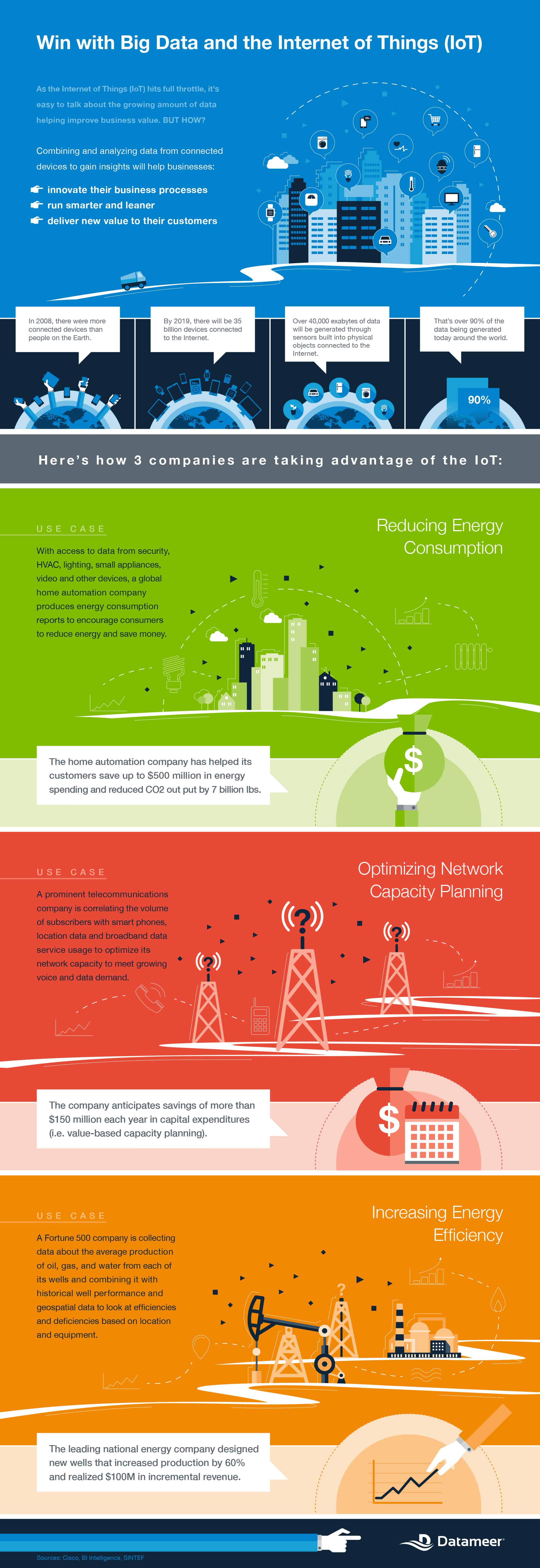As the Internet of Things (IoT) hits full throttle, it’s easy to talk about how new technologies are improving every day life. For years people have imagined a world where smart machines understand what’s happening around them in order to better serve us – from Rosie, the Jetson’s maid, to WALL-E, the small waste-collecting robot. According to recent estimates from Goldman Sachs, there will be 28 billion devices connected to the Internet by 2020, and it will be larger than the PC, tablet and smartphone markets combined.
However, what is often overlooked is that it’s not the devices per se that are causing this improvement. The reality is that the development of more devices is just further moving us into the Digital Age. Motion sensors, GPS watches, Siri and Amazon Dash are all transitioning us into an era where data is king. But these devices are just the mode in which data is collected. The real value is the ability to analyze this growing amount of data and gain insights that will impact individual lives and businesses.
The declining cost of sensors, ubiquitous connectivity and new ways to empower business users is quickly pushing along the next IoT wave. This new wave will open up opportunities for leading-edge companies to improve efficiency, launch new products and innovate. Already, companies riding the IoT wave are analyzing the growing masses of unstructured and structured data and broadening access to these insights to non-IT users. With data generated from Web logs, robots, oil wells, cell towers, servers, mobile devices and products, companies are leveraging IoT and big data analytics to improve business, increase revenues and better serve people.
Tapping into User Data to Reduce Energy Consumption
Connected homes are the top consumer market for the IoT. With access to data from meters, demographics and energy consumption, smart-meter companies have helped customers adjust their habits to reduce energy use and save money. We’ve seen one smart-meter company help its customers save up to $500 million in energy spending. With data analytics, forward-thinking energy management companies are able to run analyses on consumer thermostat data to better understand energy usage patterns. By deriving accurate and unique insights from multiple data sources, product managers can help consumers reduce energy consumption, saving both money and resources.
Driving New Athletic Advantages
Over the past few years, wearable technologies have slowly gathered more speed in transforming mainstream conceptions of health and fitness. Activity trackers, smart phone applications and smart scales have all contributed to a self-monitoring and data-collecting phenomenon dubbed the “Quantified Self” movement. The 2012 U.S. Women’s cycling team found their competitive advantage by recording and analyzing their physiological and psychological data. As a result, they went from a five-second deficit at the world championships to earning a Silver medal in the 2012 London Olympics by 8/100th of a second — a triumphant feat that was achieved not only through dedication and athletic ability, but also through enhancing training with insights gained from analyzing big data.
Bringing Sensor Data to Industry Experts to Improve Operations
The IoT is making its way deep into the earth with well sensors. An energy company is collecting data about the average production of oil, gas, and water from each of its wells and combining it with historical well performance and geospatial data to look at efficiencies and deficiencies based on location and equipment. Extending this knowledge to non-IT users, like production engineers, the company was able to lower operational spending per oil field and realize $126 million per year in incremental revenue.
Using Data-Driven Knowledge to Boost Customer Support
The IoT is also creating the opportunity for new revenue services. One enterprise hardware company combined data generated from server logs, product catalogs and customers to offer predictive maintenance and premium support. With this knowledge, support teams were able to send out replacement parts before components actually failed, and sales teams were able to look at usage patterns to improve forecasting and renewal negotiations. Combing data and analytics equipped the company with crucial insights to deliver unparalleled customer service.
With the help of data analytics, a world where intelligent machines make lives easier is not such a far-fetched idea after all. We’re seeing it emerge in the form of smart meters and sensors, and we’re already witnessing businesses reap the benefits of this new world order. Companies that capitalize on the convergence of data analytics and the IoT will undoubtedly blaze the way in their industries with unmatched innovation and customer success. As competition builds and business leaders look to new ways to deliver top-notch services, build innovative products, reduce system downtime, increase customer engagement or boost production, it would be wise to consider where you can leverage the combination of data analytics and the IoT to drive results.
Datameer‘s infographic provides an excellent overview of how businesses can make sense of the vast IoT data, to build top-notch products that will greatly influence the way we live.
 About Stefan Groschup, CEO & Co-Founder of Datameer – Stefan Groschupf is co-founder and CEO of Datameer, a provider of big-data analytics. A big-data veteran and serial entrepreneur with roots in the open-source community, Groschupf was one of the early contributors to Nutch, the open-source project that spun off Hadoop.
About Stefan Groschup, CEO & Co-Founder of Datameer – Stefan Groschupf is co-founder and CEO of Datameer, a provider of big-data analytics. A big-data veteran and serial entrepreneur with roots in the open-source community, Groschupf was one of the early contributors to Nutch, the open-source project that spun off Hadoop.
Image Credit: Mike / Activate The World / CC BY 2.0






